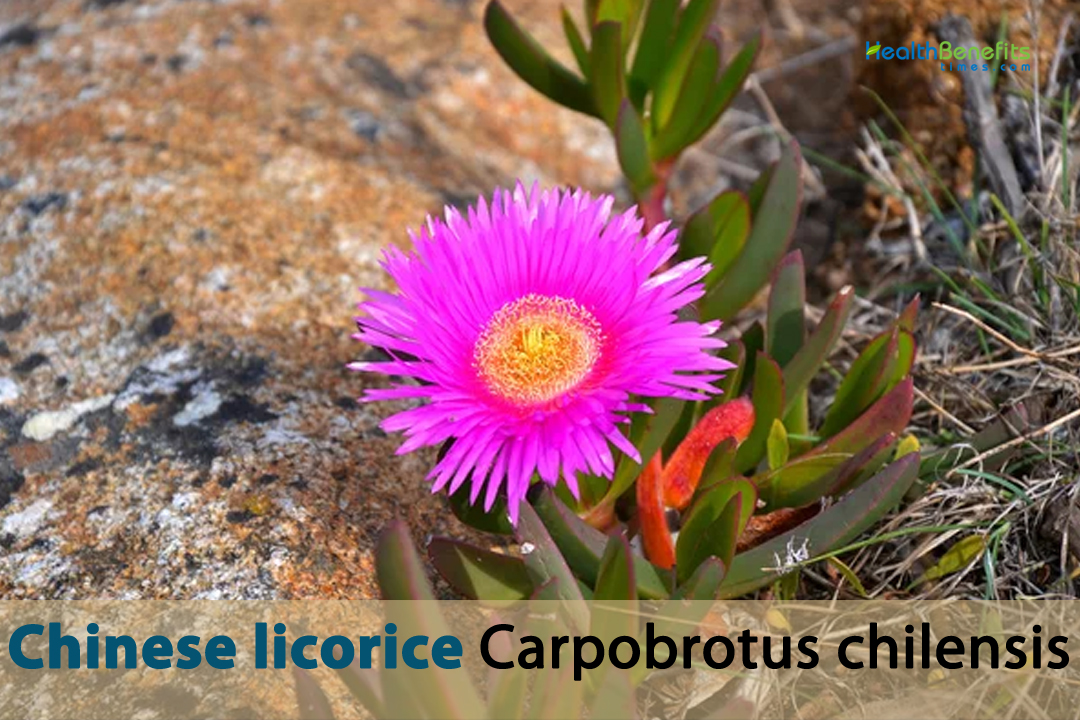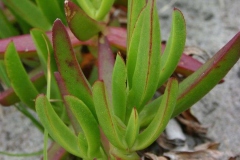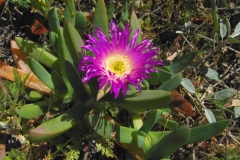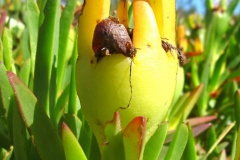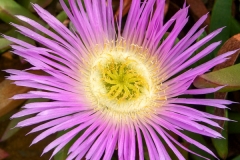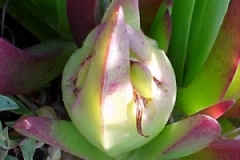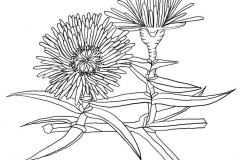| Chinese licorice Quick Facts | |
|---|---|
| Name: | Chinese licorice |
| Scientific Name: | Carpobrotus chilensis |
| Origin | China and other parts of Asia |
| Colors | Initially green or pale yellow, and tend to darken to a brownish as mature |
| Shapes | Pods are elongated and cylindrical in shape and can range in length from a few centimeters to several centimeters |
| Taste | Intensely sweet and slightly bitter flavor |
| Health benefits | Good for Immune system support, Respiratory health, Digestive support, Liver protection, Hormonal balance, Stress relief, Skin health, Dental health, Cardiovascular health, Weight management and Anti-aging properties |
| Name | Chinese licorice |
|---|---|
| Scientific Name | Glycyrrhiza uralensis |
| Native | China and other parts of Asia |
| Common Names | Sea fig, Ice plant, Baby sun-rose, Sun-rose, Chilean ice plant, Hottentot fig, Western Iceplant, Coastal Iceplant, Pigface, Beach strawberry, Fig marigold, Beach apple, Chinese Licorice, Gan Cao, Licorice Root, Sweet Root, Sweetwood, Liquorice, Licorice Plant, Russian Licorice, Wild Licorice |
| Name in Other Languages | Afrikaans: Lekkurwurzel, Chinese Leweegbos Akan: Chinese licorice Albanian: Likeri kinez Amharic: Chayn likoriz (ቻይን ሊኮሪዝ) Arabic: Alsūs (السوس), Iruq as-Sūs as-Sīnī (عرق السوس الصيني), Al-qartam al-sini (القرطم الصيني) Argentina: Doca Armenian: Chinakan karag (Չինական կարագ) Azerbaijani: Çin xeyrimənti Basque: Txinako arroza Belarusian: Kitayski likerys (Кітайскі лікерыс) Bengali: Yashtimadhu (যষ্টিমধু), China modhu (চীনা মধু) Bosnian: Kineski sladić Bulgarian: Sladŭk koren (Сладък корен), Kitayski sladnik (Китайски сладник) Burmese: Tarut ling pyin (တရုတ်လင်းပြင်) Catalan: Liquiritia xinesa Cebuano: Tsinoy nga licorice Chichewa: Licorice ya China Chile: Doca de Chile Chinese: Gāncǎo (甘草), Hǎi wúhuāguǒ ( 海無花果), Chaina likoris (চায়না লিকোরিস) Corsican: Licorizia cinese Croatian: Sladić, Kineski sladić Czech: Líkořice, Čínský lékořice Danish: Lakridsrod, Kinesisk lakrids Dutch: Zoethout, Chinese zoethout English: Sea fig, Chinese licorice, Licorice root, Gan Cao Esperanto: Ĉina lakrido Estonian: Lagritsajuured, Hiina lagrits Filipino: Tsino-likorisa Finnish: Lakritsijuuri, Kiinalainen lakritsi French: Réglisse, Réglisse chinoise Frisian: Sineeske sûkelade Galician: Alcazuz chines Georgian: Chinuri likeri (ჩინური ლიკერი) German: Süßholz (Süßholzwurzel), Chinesische Süßholz , Chinesische Süßholzwurzel Greek: Glykoriza (Γλυκόριζα), Kinezikí glykóridza (Κινεζική γλυκόριζα) Gujarati: Chainijh likoris (ચાઇનિઝ લિકોરિસ), Chainā madhu (ચાઇના મધુ) Haitian Creole: Lakwiris Sinit Hausa: Licorice, Chinese licorice Hawaiian: Rēkereki Hainan Hebrew: Shosh sinai (שוש סיני) Hindi: Mulēthī (मुलेठी), Cheeni mulethi (चीनी मुलेठी) Hmong: Chinese licorice Hungarian: Édesgyökér, Kínai édesgyökér Icelandic: Lakkrí, Kínversk lakkrís Igbo: Nzuza , Nriịsi China Indonesian: Licorice Cina Irish: Luibhseach Síneach Italian: Liquirizia , Liquirizia cinese, Radice di liquirizia cinese Japanese: Kanzō (甘草), Kanzō no ne (甘草の根) Javanese: Licorice Cina Kannada: Yaṣṭimadhu (ಯಷ್ಟಿಮಧು), Chīnīya likoris (ಚೀನೀಯ ಲಿಕೊರಿಸ್), Cīnīya laksha (ಚೀನೀಯ ಲಕ್ಷ) Kazakh: Kitay özeni (Китай өзені) Khmer: Khesakateachin (ខ្សែកាត់ចិន) Korean: Gamcho (감초), Jungguk gamcho (중국 감초) Kurdish: Siwka Çînî Kyrgyz: Kytaı jumashygy (Кытай жумашыгы) Lao: Khamphaao jin (ກຳພ້າວຈີນ) Latin: Radix Glycyrrhizae Sinitic Latvian: Salda kārpa, Ķīniešu lakrica Lithuanian: Saldaus šaknis, Kinų saldymedis Luxembourgish: Chinesesch Lakrëtz Macedonian: Kineski sladnik (Кинески сладник) Malagasy: Voanjo tsinaina Malay: Licorice Cina Malayalam: Irattimathi (ഇരട്ടിമതി), Chainīs likkarīs (ചൈനീസ് ലിക്കറീസ്), Chainīs sukhanaashini (ചൈനീസ് സുഖനാശിനി) Maltese: Lakrizja, Liquriza Ċiniża Maori: Rīwha Haina Marathi: Chāyanījh likoris (चायनीज लिकोरिस), Cāyanījha madhu (चायनीझ मधु) Mongolian: Khyatad üzesgelen (Хятад үзэсгэлэн) Myanmar (Burmese): Tarut ling pyin (တရုတ်လင်းပြင်) Nepali: Cheeni madhu (चीनी मधु) Norwegian: Lakrisrot, Kinesisk lakris Pashto: Cheeni meyrwokh (چیني مېړوکښ) Persian: Glycyrrhiza glabra (گلیسیریزا گلابرا), Glycyrrhiza-ye Chini (گلیسیریزای چینی) Polish: Lukrecja, Chiński lukrecja Portuguese: Alcaçuz, Alcaçuz chinês Punjabi: Chīnī mulēthī (ਚੀਨੀ ਮੁਲੇਠੀ), Chīnī madh (ਚੀਨੀ ਮਧ) Romanian: Lemn dulce, Lemn dulce chinezesc Russian: Lakrichnik (Лакричник), Kitayskiy lakrichnik (Китайский лакричник) Samoan: Suamalie Saina Scots Gaelic: Licorice Sìneach Serbian: Slatki koren (Слатки кoрен), Kineski slatkiš (Кинески слаткиш) Sesotho: Chinese licorice Shona: Licorice yaChina Sindhi: چائيني جي ميٽي Sinhala: Alim (අලිම්), Chīna mēsisā (චීන මැසිසා) Slovak: Sladký koreň, Čínska sladké drievko Slovenian: Sladki koren, Kitajska sladika Somali: Dhirirka Shiinaha Spanish: Regaliz, Regaliz chino, Regaliz chino, Bàlsam, Dent de lleó, Hierba del cuchillo, Patata frita, Ungla de moix, Uña de gato Sundanese: Licorice Cina Swahili: Asali ya mnyonyo, Mdalasini wa Kichina Swedish: Lakritsrot, Kinesisk lakrits Tajik: Shirini Chini (Ширини Чинӣ) Tamil: Athimadhuram (அதிமதுரம்) , Cīṉa attimathuram (சீன அத்திமதுரம்) Telugu: Aṭavīmadhu (అటవీమధు), Chainīs likōrīs (చైనీస్ లికోరీస్) Thai: Wān hăang já rá khê (ว่านหางจระเข้), Hăang já rá khê (หางจระเข้), Kam tham (คำถาม), Kam tham jin (คำถามจีน) Turkish: Meşe kökü, Çin meyan kökü Turkmen: Hytaý duzgalmagy Ukrainian: Likoris (Лікоріс), Kitays’kyy lakrytsya (Китайський лакриця) Urdu: Cheeni mulath (چینی ملیٹھی) Uzbek: Xitoy shirinlik Vietnamese: Cam thảo Welsh: Llygad Melys Tsieineaidd Xhosa: Licorice yesiChine Yiddish: Tsheyneze glikorits (טשיינעזע גליקאָריץ) Yoruba: Osu, Agunmu Sin-China Zulu: Udokotela, Ilayikhawu yesi-China |
| Plant Growth Habit | Succulent, evergreen, herbaceous perennial plant |
| Growing Climates | Coastal scrub, grasslands, chaparral, bluffs, costal dunes, beaches, margins of estuaries and along roadsides |
| Soil | Well-draining, loamy or sandy soils with a pH range of 6.0-8.0. The soil should be fertile, rich in organic matter, and have good moisture retention |
| Plant Size | About 1 to 1.5 meters (3 to 5 feet) and have a spread of around 0.5 to 1 meter (1.5 to 3 feet) |
| Root | Long, slender, and woody. They can reach a length of up to one meter and have a yellowish-brown to dark brown color |
| Stem | Stem is segmented into nodes and internodes. Nodes are the points along the stem where leaves, buds, or branches are attached. Internodes are the sections of the stem between two adjacent nodes |
| Bark | Rough and fibrous, especially in older and more mature plants. The outer surface may appear slightly wrinkled or have irregular ridges |
| Leaf | Each compound leaf typically consists of several pairs of leaflets arranged along a central stalk called the rachis |
| Flowering season | May to June |
| Flower | Flowers are deep magenta, up to 1 inch (2.5 cm) in diameter, and appear all year round. They open in the morning and close at night |
| Fruit Shape & Size | Pods are elongated and cylindrical in shape and can range in length from a few centimeters to several centimeters |
| Fruit Color | Initially green or pale yellow, and tend to darken to a brownish as mature |
| Seed | Typically small, measuring around 2-3 millimeters in length. They have an oval to oblong shape with rounded ends |
| Flavor/Aroma | Warm and earthy, with hints of honey and a subtle herbal undertone |
| Taste | Intensely sweet and slightly bitter flavor |
| Plant Parts Used | Root, rhizomes, root bark, stem and leavers |
| Propagation | By seed, Root Division, Root Cuttings |
| Lifespan | Live for about 10 to 15 years. However, with proper care and favorable conditions, they may live even longer |
| Season | August to September |
| Major Nutrition |
|
| Health Benefits |
|
| Available Forms |
|
Plant Description
Chinese licorice is an annual herbaceous succulent plant that grows between 3 and 5 feet tall and spreads between 0.5 and 1 meter (1.5 to 3 feet). The plant grows in coastal scrub, grasslands, chaparral, bluffs, coastal dunes, beaches, along the edges of bays, and by the side of roads. The plant grows in soils with a pH between 6.0 and 8.0 that drain well and are sandy or loamy. The soil should be rich in organic matter, hold water well, and be healthy. It should also be able to drain water properly. Avoid wet or clay-heavy soils, which can cause root rot. Plants can grow and make fruit at any time of the year. The flowers open up in the morning and close up at night.
Appropriate growing environments for Chinese licorice
Chinese licorice thrives in specific growing environments that provide optimal conditions for its growth and development. Here are the appropriate growing environments for Chinese licorice:
- Climate: Chinese licorice comes from temperate areas and does best in a continental environment with warm summers and cold winters. It grows best in places with moderate temperatures and adequate sunlight. During the growing season, the best temperature range for Chinese licorice is between 68 and 86°F (20 and 30°C).
- Sunlight: For best growth, Chinese licorice needs full sun to light shade. Every day, it should get at least 6–8 hours of direct sunlight. But it can stand some shade, especially when it’s hot in the summer.
- Soil: Chinese licorice grows best in soils that drain well and have a pH between 6.0 and 8.0. The soil should be rich in organic matter, hold water well, and be healthy. It should also be able to drain water properly. Avoid wet or clay-heavy soils, which can cause root rot.
- Watering: Chinese licorice likes to be watered often so that the soil stays wet. However, it is crucial to avoid waterlogging or overwatering, as it can lead to root rot. It’s important to give plants enough water when it’s dry, especially when their roots are just starting to grow.
- Spacing: Chinese licorice plants need enough space between them to grow well and get enough air. Place the plants about 12 to 24 inches (30 to 60 cm) apart in each row and between rows, based on how much space you have and how the particular variety grows.
- Weed Control: Weeds can hurt the growth of Chinese licorice. Weeding and planting around the plants on a regular basis slows the growth of weeds and keeps them from competing with the plants for nutrients and water.
- Winter Dormancy: Chinese licorice is a plant that comes back every year and goes to sleep in the winter. It needs a time of cold dormancy to help the roots grow and get stronger. In places where it gets very cold, covering plants with mulch in the winter can help protect them from the cold and keep the soil temperature stable.
Root
Roots are usually long and thin, and can often grow up to one meter long. They are round and have a woody feel to them. The root’s outside is rough and has lots of small, irregular bumps. These bumps make the root look like it has wrinkles. The color of roots can change based on things like how old the plant is and how it was prepared. Generally, the roots have a yellowish-brown to dark brown color. There are many different shades of brown, from lighter shades to deeper, darker ones.
When you cut the root open, you will see that it is made up of different layers. The top layer, known as the bark or cortex, is rough and fibrous. Under the bark is a layer called the cambium, which is in charge of making new cells. The layer of cambium covers the root’s central core, which is the woody part with the most active compounds. The roots are brittle and a little bit woody. The rough bark on the outside can be peeled off to show the softer layers inside. The center is harder and thicker than the layers around it. The size and shape of roots can change. They are usually long and thin, but the exact length and width can change based on the age of the plant and how it was grown. Some roots are pretty straight, while others have bends or turns.
Stem
Like the roots of most plants, stem is made up of several different parts. The nodes, internodes, buds, leaves, and circulatory tissues are all a part of these parts. The stem is made up of nodes and spaces between them. The leaves, buds, and branches of a plant are connected to the stem at nodes. The parts of the stem between two nodes are called internodes. The length and thickness of the internodes can change based on where the plant is in its growth cycle and how its surroundings is.
There are vascular cells in the stem that carry water, nutrients, and sugars to all parts of the plant. The xylem and phloem are two of these tissues. The xylem moves water and minerals from the roots to the rest of the plant. The phloem moves sugars made by photosynthesis to different parts of the plant. The stem is made of plants and is not as hard as the roots. It has a less fibrous and woody feel and gives the plant freedom and support.
Bark
Bark is the covering layer on the outside of the stem that is made of wood. It consists of several layers of tissues that provide support and safety to the underlying stem. The bark can have a different feel based on how old the plant is. In general, the bark is rough and fibrous, especially on larger and more mature plants. The surface may have small wrinkles or bumps that don’t line up. The bark can also be different colors. It is usually a light brownish-gray color or a darker brown. But the exact shade of brown can change based on things like how old the plant is and how the environment is.
How thick the bark is can change based on how old the stem is. Younger plants may have thinner, more flexible bark, while older, more developed plants tend to have bark that is thicker and harder. The bark protects the stem from mechanical damage, disease-causing organisms, and environmental factors. It keeps from losing too much water through evaporation and keeps the temperature from changing too much.
Leaves
Along the stem, the leaves are grouped in pairs. This means that each leaf is connected to the stem at a different point, switching sides with each node. The leaves are complex, which means they are made up of several smaller leaves. The leaflets of a compound leaf are usually grouped in pairs along a central stalk called the rachis. There can be anywhere from 9 to 17 leaflets on a complex leaf, but this is usually the case.
Most of the time, each leaflet is oval or lanceolate in shape. The base of ovate leaves is wider than the tip, making them look like eggs. Lanceolate leaves are long and thin, and both ends come to a point. Leaflets can be different sizes, but most are between 2 and 6 centimeters long. The leaves have a smooth, often shiny surface. They are thin and have a feel like a membrane. They are usually soft to the touch. The top surface is usually a darker green than the bottom surface, which is usually a lighter green.
Pinnate venation means that each leaflet has a noticeable central vein running down the middle. This vein is called the midrib. From the midrib, smaller veins branch out to make a network of veins that move water, nutrients, and sugars all over the leaflet. The margin, or edge, of the leaflets can vary, but it is usually smooth or slightly serrated. Serrations are small, sharp protrusions along the edge of a leaflet that look like teeth. The leaves are usually a bright, dark green color, which shows that they are healthy and making food through photosynthesis.
Flowers
Flowers grow in groups called racemes that are thick and long. These racemes are usually terminal, meaning they are located at the ends of branches or stems. Each flower is small and has a structure that is hard to describe. Most of the flowers are bisexual, which means that they have both male and female parts. The corolla is the tube-like part of a flower made up of five petals that are joined at the base. The corona of most flowers is light purple to lavender in color, but there are exceptions. The five sepals that surround the flowers are joined at the bottom to make a tube-like structure called the calyx. Before the flower opens, the calyx covers the flower bud as it grows. Most of the time, the sepals of flowers are green.
Inside the tube of the corolla, there are generally ten stamens. These are the male parts of the flower that reproduce. There is a thread and an anther on each stamen. Pollen is made in and released from the flower by the anthers. There is one pistil, which is the female reproductive part, in the middle of the flower. There is an ovary, a style, and a stigma on the pistil. After being pollinated and fertilized, the ovules in the ovary turn into seeds. The stigma is the part of the flower that lets the pollen stick to it. Flowers often smell sweet and soft, which makes them more appealing.
Fruit
Fruits are small, dry structures with seeds inside. These structures are called legumes or pods. Chinese licorice is a member of the family Fabaceae, which is made up of plants with legumes. Most Chinese licorice fruits are long and tubular, so they look like skinny pods. Depending on the type and how old the fruit is, they can be a few centimeters long or several centimeters long.
Depending on the type of food and how old it is, its color can be different. At first, the fruit may be green or pale yellow, but as it ripens, it tends to turn a darker brown color. Fruits have a dry, almost leathery feel to them. The outside of the fruit is either smooth or has small bumps or wrinkles. Fruits are usually dehiscent, which means they split open along specific lines or seams to release the seeds inside. When the pod dries out and gets smaller, it often causes the fruit to split or open up.
Seeds
Most seeds are small, measuring only about 2 to 3 millimeters long. They are oval to oblong in shape, and the ends are pointed. Most of the time, the seeds are shiny and dark brown or black in color. The outermost skin of the seed is called the seed coat or testa. It is tough and hard, protecting the parts of the seed that are inside. The coat of the seed is smooth and dark brown in color. The seed coat has a small scar called the hilum. It shows where the seed joins the structure that makes the fruit. Most of the time, the hilum is at one end of a Chinese licorice seed.
History
In China, people have been eating Chinese licorice for thousands of years. It is thought to be one of the oldest and most important herbs used in traditional Chinese treatment. Chinese licorice was first mentioned in a book called “Shennong Ben Cao Jing” (Divine Farmer’s Materia Medica), which was written around 200 BCE. This text talks about the health benefits and uses of several herbs, including Chinese licorice. Throughout history, many medical books have written a lot about Chinese licorice. Li Shizhen wrote the “Ben Cao Gang Mu” (Compendium of Materia Medica) during the Ming Dynasty in the 1600s. It has a lot of information about the biology, pharmacology, and medical uses of Chinese licorice. It talks about how it balances the body, gets rid of heat, calms coughs, and moistens the lungs.
Along the old Silk Road, Chinese licorice was a very important part of trade and cultural exchange. It became famous in nearby countries like Japan, Korea, and India, where it became a key herb in their traditional medicine systems. Western herbalism has also taken notice of Chinese licorice, which is now used in a number of herbal preparations and supplements.
In the last few decades, scientists have become interested in Chinese licorice, which has led to a lot of study on its phytochemical components and medicinal properties. Researchers have looked into the anti-inflammatory, antiviral, antioxidant, and liver-protecting benefits of its bioactive compounds, such as glycyrrhizin, flavonoids, and triterpenoids. This study has helped confirm how it has been used in the past and find new ways to use it as a medicine.
Chinese licorice is still an important herb in traditional Chinese medicine and is grown, sold, and used all over the world. It is used in a wide range of plant formulas, teas, decoctions, and medicines to treat things like respiratory problems, digestive problems, hormonal imbalances, and to help the immune system.
Varieties of Chinese licorice
Chinese licorice is a versatile plant that has several varieties. Here are some notable varieties of Chinese licorice:
- Gancao: Gancao is the most popular type of Chinese licorice that is grown on a large scale. It is known for having a lot of the compound glycyrrhizin, which gives it its sweet taste and medicinal qualities. Gancao is used a lot in traditional Chinese medicine because it reduces inflammation, helps you cough up mucus, and brings everything back into balance.
- Baishaoyao: White peony root, which is also called baishaoyao, is often used with Chinese licorice because the two work well together. It is made from the root of a growing plant called Paeonia lactiflora. Traditional Chinese medicine gives Baishaoyao a lot of credit for being able to strengthen the blood, ease pain, and control menstruation.
- Gancaozhi: Gancaozhi is the Chinese word for the stem and root of licorice. It is taken from the plant when it is still young and has a higher number of compounds that make it work. Gancaozhi is often used in plant decoctions and preparations to strengthen the body, soothe the throat, and help keep the lungs healthy.
- Zhigancao: Zhigancao is a type of Chinese licorice that is known for having a thin, woody root. People think that it has a softer taste than other kinds. Zhigancao is often used in traditional Chinese herbal formulas to make the acts of different herbs work better together and boost their effectiveness.
- Gancaogancao: Gancaogancao is a type of Chinese licorice that has been grown for its high level of glycyrrhizin. It is mostly used to make licorice extract, which is a sweetener and flavoring agent that is often used in the food and candy industries.
- Gancaozhi: This type of Chinese licorice is all about the plant’s roots and stems. It is taken from the plant at a younger age and is known for having more active chemicals. Gancaozhi is often used in traditional medicine because it is good for the health of the lungs and body as a whole.
- Zhi Gancao: Zhi Gancao is a type of Chinese licorice that has been made in a way called “zhi.” Before they are used, licorice roots are usually steamed or fried. People think that this way of processing the licorice makes its healing qualities better. Zhi Gancao is often used in recipes to feed the Qi (vital energy), balance the middle burner (digestive system), and relieve pain.
- Yuan Zhi: Even though Yuan Zhi is not a type of Chinese licorice, it is a different plant that is often used with Chinese licorice in traditional medicine. It comes from the roots of a herb called Polygala tenuifolia. Yuan Zhi is known for its calming and sleep-inducing effects, and it is often used with Chinese licorice to improve memory, ease nervousness, and help people get a good night’s sleep.
- Xiao Gancao: “Small licorice,” which is what “Xiao Gancao” means, is a part of the Chinese licorice plant. The smaller, shorter root that grows from the main root is the branch. People often use Xiao Gancao instead of the main root because they think it has a softer taste. In traditional medicine, it is used to make sure that the benefits of other herbs work well together and to reduce any possible side effects.
- Chao Gancao: Chinese licorice that has been stir-fried or fried in honey or other things is called Chao Gancao. People think that this way of processing the licorice changes its healing qualities. Chao Gancao is often used in traditional medicine because it can strengthen and balance the body, especially the gut system.
- Gancaozi: Gancaozi are the seeds of the licorice plant from China. These small seeds have chemicals that are good for you and are used in traditional medicine because of this. Gancaozi is often mixed with other herbs to improve their healing benefits.
- Qing Gancao: Qing Gancao, which is also called “green licorice,” is a type of Chinese licorice that is picked when it is still young. It has a greenish color and a weaker flavor than licorice roots that have fully grown. In some plant recipes, Qing Gancao is often used instead of Gancao.
- Mulethi: While Chinese licorice is the most popular variety, there is also another species known as Mulethi or Glycyrrhiza glabra. Mulethi comes from parts of Asia, Europe, and the Middle East. It is used in ancient Ayurvedic and Unani medicine and has some of the same effects as Chinese licorice.
- Wild Licorice: Wild licorice, which is called Glycyrrhiza lepidota by scientists, is another type. This species is native to North America and has been used in Native American traditional healing. Even though it is not as popular as Chinese licorice, it has some of the same chemical components and may be useful as a medicine.
- Deglycyrrhizinated Licorice: DGL is a type of licorice extract that is made in a special way. It is not a type of Chinese licorice. It goes through a process to get rid of or lower the amount of glycyrrhizin, which gives it its sweet taste but can also cause side effects.
Health benefits of Chinese licorice
Chinese licorice is a medicinal herb that has been used in traditional Chinese medicine for centuries. It is highly regarded for its numerous health benefits. Here are some of the key health benefits of Chinese licorice
1. Anti-inflammatory properties
Compounds like glycyrrhizin, liquiritin, and isoliquiritigenin found in Chinese licorice have strong anti-inflammatory benefits. These compounds help lower inflammation in the body. Because of this, they can be used to treat conditions like arthritis, asthma, and inflammatory bowel disease that cause inflammation.
2. Immune system support
Glycyrrhizin, which is found in Chinese licorice, has been shown to help the defence system work better. It makes immune cells like lymphocytes and macrophages make and use more of themselves, which helps the body fight off infections and diseases.
3. Respiratory health
Chinese licorice has been used for a long time to help keep the lungs healthy. It works as an expectorant, which means it helps get mucus and gunk out of the lungs. Because of this, it can help with things like coughs, pneumonia, and asthma. Chinese licorice can also help relax and widen the lungs, making it easier to breathe.
4. Digestive support
Chinese licorice makes the digestive system feel better. It helps reduce inflammation in the gut and speeds up the healing of ulcers and other problems of the digestive tract. Chinese licorice can also make your body make more stomach enzymes, which help break down food and get the nutrients you need.
5. Liver protection
The bioactive chemicals in Chinese licorice have been shown to protect the liver from damage. This is called hepato-protective properties. It helps the body get rid of toxins, keeps the liver working well, and may even help liver cells grow back.
6. Anti-viral and anti-bacterial effects
Chinese licorice has antiviral and antibacterial qualities that make it useful against a wide range of diseases. Studies have shown that it can stop the spread of some viruses, such as the herpes simplex virus and respiratory viruses. It can also stop bacterial attacks and help the body’s natural defenses work better.
7. Hormonal balance
There are plant chemicals called phytoestrogens in Chinese licorice that act like estrogen in the body. Because of this, it can help balance hormones, especially in women going through menopause. Chinese licorice can help with menopause symptoms like hot flashes, mood swings, and other hormonal changes.
8. Stress relief and adrenal support
Chinese licorice has qualities that help the body adapt to stress and keep stress hormone levels normal. It helps the adrenal glands, which make stress hormones like cortisol. This may help fight the bad effects of long-term worry.
9. Skin health
Chinese licorice has been put on the face to treat eczema, psoriasis, and acne, among other things. It can help soothe sensitive skin, reduce redness, and speed up healing by reducing inflammation and killing germs.
10. Anti-allergic effects
Compounds found in Chinese licorice have been shown to help people with allergies. It can help ease allergy symptoms like itching, coughing, and stuffy noses. Chinese licorice may also modulate the immune response to allergens, lowering the severity of allergic reactions.
11. Anti-ulcer activity
Chinese licorice has been used to treat ulcers and stomach problems for a long time. It helps inhibit the growth of Helicobacter pylori, a bacterium linked with stomach ulcers. Chinese licorice can also stop the stomach from making too much acid, which can help with heartburn and acid reflux.
12. Anti-diabetic effects
Chinese licorice might be able to help keep blood sugar levels in check. It can boost the production of insulin, the hormone responsible for glucose uptake and regulation. Chinese licorice may also make insulin work better, which could help people with diabetes or who are at risk of getting the disease.
13. Anti-cancer properties
Studies have shown that some of the chemicals in Chinese licorice, like glycyrrhizin and liquiritin, may help fight cancer. They have been shown to stop cancer cells from growing and to cause apoptosis (cell death) in breast, prostate, and liver cancers, among others. However, further study is needed to fully understand the potential of Chinese licorice in cancer treatment.
14. Anti-anxiety and antidepressant effects
Traditionally, anxiety and sadness were treated with Chinese licorice. It has chemicals in it that can have a calming effect on the nervous system and help lower anxiety and promote a feeling of well-being. It may also boost the production of neurotransmitters such as serotonin, which plays a crucial role in mood regulation.
15. Anti-microbial activity
Chinese licorice has been shown to kill many different kinds of bacteria and fungus. It can stop the growth of bad microorganisms, such as those that cause illnesses. Some natural antiseptics contain Chinese licorice, which has been used to treat skin diseases by putting it on the affected area.
16. Dental health
Chinese licorice has long been used to help keep teeth healthy. Its antimicrobial qualities can help fight the bacteria that cause dental plaque, cavities, and gum disease. Chinese licorice can also make gums less sore and help keep teeth clean.
17. Cardiovascular support
Chinese licorice might be good for the health of your heart. It has been found to have antioxidant and anti-inflammatory benefits, which can help protect blood vessels from damage and lower the risk of heart disease. Chinese licorice may also help keep cholesterol levels and blood pressure in a healthy range.
18. Weight management
Chinese licorice might help people lose weight. It has been shown to help fight obesity by changing how lipids are used and preventing fat from building up. Chinese licorice can also help control hunger and cravings, which could help people lose weight.
19. Anti-aging properties
Chinese licorice has antioxidants in it that can help fight free radicals, which are dangerous molecules that speed up aging and damage cells. Chinese licorice can help protect the skin and other organs from oxidative stress by being eaten or put on the skin regularly. This can make the skin look younger.
20. Cognitive support
Some tests show that Chinese licorice may help your brain work better. Animal tests have shown that it helps animals remember things and learn new things. Chinese licorice may also have traits that protect the brain, which could help keep the brain healthy and lower the risk of age-related memory loss.
Culinary uses of Chinese licorice
Chinese licorice is not only valued for its medicinal properties but also has culinary uses in certain cuisines. Here are some culinary applications of Chinese licorice:
- Flavoring Agent: Chinese licorice has a sweet taste that stands out, and it can be used in cooking as a natural sweetener and flavour booster. It gives foods and drinks a subtle, earthy sweetness. It is often used to add a mild sweetness and balance the flavours in Chinese vegetable soups, broths, and teas.
- Traditional Desserts: Chinese licorice is sometimes used in Chinese sweets and treats that have been around for a long time. It has a unique taste that can be added to sweet rice meals, puddings, herbal jellies, or candies. Mixing Chinese licorice with other items makes a taste that goes well together.
- Condiments and Marinades: Chinese licorice can be added to marinades, sauces, and seasonings to make the flavours more interesting and deep. It can be used to add sweet and herbal notes to spice mixes, rubs, or sauces for meats or veggies.
- Chinese Herbal Cuisine: Chinese licorice is often used in Chinese herbal cooking, which combines herbs and other ingredients to make dishes that are both tasty and good for you. It is used in soups, stews, and braised meals with other medicinal herbs to improve the taste and health benefits of the dish as a whole.
- Traditional Medicine Beverages: Chinese licorice is good for you, so it is used in traditional Chinese herbal teas and healing drinks. It is mixed with other herbs to make tonics or drinks that are good for your health. People drink these drinks not only because they taste good but also because they might be good for their health.
- Herbal Infusions and Teas: Chinese licorice can be infused in hot water to make delicious herbal teas. It can be mixed with other herbs and spices, like ginger or cinnamon, to make infusions that are healing and smell good. People think that Chinese licorice tea can help calm and settle the stomach.
- Baking and Desserts: Because of its unique taste, Chinese licorice can be added to baked items and desserts. It can be added to recipes for cookies, cakes, and bread to give them a hint of sweetness and a hint of herbs. Licorice powder or extract can also be used to add a unique flavour to sweet sauces, ice creams, and custards.
- Herbal Seasonings and Spice Blends: Chinese licorice can be ground into a powder and used as a seasoning or spice mix in cooking. It can be mixed with other herbs and spices to make marinades, rubs, and dressing mixes with unique tastes. The addition of Chinese licorice can add richness and depth to savoury dishes.
- Medicinal Soups and Broths: Chinese licorice is often used in traditional Chinese medicine soups and broths. It is mixed with other herbs, veggies, and proteins to make dishes that are tasty and good for your health. People think that these soups and broths help keep the body healthy and in balance.
- Herbal Liqueurs and Digestifs: Herbal liqueurs and digestives can be made with licorice from China. Because of its unique taste and possible health benefits, it can be used to make herbal-infused drinks. It can be macerated or steeped in alcohol to bring out its flavours and qualities.
- Herbal Syrups and Elixirs: Herbal syrups and elixirs can be made with licorice from China. The . These syrups can be used as a natural sweetener in drinks or spread over desserts or pancakes.
- Pickling and Fermentation: Chinese licorice can be used to add flavour and depth to pickling and fermentation procedures. Along with other ingredients, such as vegetables and fruits, it can be added to pickling brines or fermentation vessels. The licorice imparts a distinct flavour and contributes to the preserved food’s overall flavour profile.
- Herbal Infused Oils and Vinegars: Oils and vinegars can be infused with Chinese licorice to produce aromatic and flavorful condiments. The licorice-infused oil can be used to lend a subtle sweetness to stir-fries, dressings, or as a finishing oil. Similarly, vinegar infused with licorice can be utilized in marinades, condiments, and as a dipping condiment.
- Traditional Medicinal Concoctions: Chinese licorice can be used in traditional medicinal concoctions in addition to herbal beverages. These may consist of decoctions or botanical mixtures created by simmering Chinese licorice with other herbs and ingredients. These mixtures are ingested for their presumed health-promoting properties and potential therapeutic effects.
- Alcoholic Beverages: Chinese licorice can be used to create alcoholic beverages like liqueurs and bitters. Its distinctive flavour and potential health benefits make it an intriguing ingredient for distilling spirits infused with herbs. Licorice contributes to the overall flavour profile and can add complexity to mixed beverages and cocktails.
Different uses of Chinese licorice
Chinese licorice is a popular herb widely used in traditional Chinese medicine (TCM) and various other applications. Here are some different uses of Chinese licorice:
- Flavoring Agent: In many traditional Chinese herbal formulations, teas, and candies, Chinese licorice is used as a natural sweetener and flavour enhancer. It is commonly used to temper bitterness and enhance the overall flavour of herbal preparations with its sweet flavour.
- Cosmetics and Skincare: Due to its potential skin-soothing and anti-inflammatory properties, Chinese licorice is a constituent in a number of cosmetic and skincare products. It is frequently used in moisturizers, lotions, and ointments to soothe irritated skin, diminish redness, and promote a healthy complexion.
- Animal Feed Additive: Extracts or powders of Chinese licorice are occasionally used as a natural feed additive in the livestock and poultry industries. It is believed to have potential health, digestion, and growth benefits for animals.
- Brewing and Distilling: Occasionally, Chinese licorice is used in fermenting and distilling processes, especially in traditional herbal liqueurs, spirits, and certain types of beer. It can contribute to the product’s flavour profile and lend a touch of sweetness.
- Aromatherapy and Fragrance: Chinese licorice has a distinct scent that some individuals find appealing. It may be used in aromatherapy to create soothing or grounding aromas in essential oil blends or fragrances.
- Soil Amendment: The roots of Chinese licorice plants possess nitrogen-fixing properties. This indicates that they can convert atmospheric nitrogen into a form that is more readily absorbable by plants. Therefore, Chinese licorice can be used as a soil amendment to enhance soil fertility and plant growth.
- Natural Preservative: In certain culinary products, licorice extract or powder has been used as a natural preservative. Its antimicrobial properties may aid in prolonging the expiration life of perishable goods.
- Traditional Soap Making: Chinese licorice can be used as a natural ingredient in handmade soap recipes. It may contribute to the soap’s texture, fragrance, and potential skin-soothing properties.
- Veterinary Medicine: In veterinary medicine, Chinese licorice has been utilized to promote animal health. It can be incorporated into herbal formulations or dietary supplements for animals to treat a variety of conditions, including respiratory issues, digestive disorders, and inflammation.
- Traditional Crafts: The root of Chinese licorice has been utilized in traditional crafts, including the creation of natural dyes and aromatic sachets. These artistic endeavours can be enhanced by the root’s natural colour and aroma.
- Environmental Applications: Environmental applications of Chinese licorice, such as soil erosion control and phytoremediation, have been studied. Its ability to assimilate heavy metals from contaminated soil and its deep root system make it a potential environmental cleanup tool.
- Flavoring in Tobacco Products: Occasionally, Chinese licorice is used as a flavouring agent in tobacco products like pipe tobacco and herbal smoking mixtures. It can impart a subtle sweetness and enhance the overall flavour profile.
- Traditional Fiber Extraction: Historically, the stems of Chinese licorice plants were used to extract fibres. These fibres can be spun into threads or woven into textiles for a variety of applications, including traditional apparel and home furnishings.
- Cultural and Ritual Uses: In certain regions, Chinese licorice has cultural significance and is occasionally employed in traditional ceremonies, rituals, and celebrations. It may represent good fortune, safety, or be incorporated into particular cultural practices.
Side effects of Chinese licorice
While Chinese licorice is generally considered safe when used appropriately, it is important to be aware of potential side effects, especially when consumed in large amounts or used over an extended period. Here are some side effects associated with Chinese licorice:
- Hypertension and Sodium Retention: Some people who consume Chinese licorice may experience an increase in blood pressure and sodium retention due to the presence of glycyrrhizic acid. Consuming Chinese licorice for an extended period of time or in excess may result in fluid retention, electrolyte imbalances, and a worsening of elevated blood pressure.
- Potassium Depletion: The glycyrrhizic acid in Chinese licorice can also induce potassium excretion, potentially resulting in hypokalemia (low potassium levels). This can have negative effects on cardiovascular function, muscle frailty, and other complications.
- Hormonal Imbalances: Chinese licorice contains phytoestrogens, plant compounds that mimic estrogen’s effects on the body. In women, excessive or protracted use of Chinese licorice may disrupt hormone levels and lead to hormonal imbalances. This may affect menstrual cycles, fertility, and other hormone-dependent processes.
- Interactions with Medications: Certain medications, including corticosteroids, digoxin, diuretics, and some blood pressure medications, can interact with Chinese licorice. It may impair their efficacy, increase the likelihood of adverse effects, or alter drug metabolism. Before using Chinese licorice, it is necessary to consult a healthcare professional if you are currently taking medication.
- Allergic Reactions: Some people may be allergic to Chinese licorice, resulting in rashes, itching, puffiness, and difficulty breathing. Stop using Chinese licorice and seek medical attention if you experience any allergic reactions after consuming it.
- Interference with Electrolyte Balance: Chinese licorice can affect the equilibrium of electrolytes such as calcium, magnesium, and sodium in the body. This may result in imbalances and associated symptoms.
- Hypertension: Chinese licorice contains glycyrrhizin, a compound that can cause an increase in blood pressure. In some individuals, prolonged or excessive licorice consumption may contribute to the development or exacerbation of hypertension.
- Decreased testosterone levels: In men, excessive consumption of licorice may reduce testosterone levels. This may result in libido loss, erectile dysfunction, and fatigue.
References:
https://gd.eppo.int/taxon/CBSCH
https://en.wikipedia.org/wiki/Carpobrotus_chilensis
http://www.theplantlist.org/tpl/record/kew-2701239
https://tropical.theferns.info/viewtropical.php?id=Carpobrotus+chilensis
http://ngp.parc.gov.pk/gringlobal/taxon/taxonomydetail?id=101171
https://www.itis.gov/servlet/SingleRpt/SingleRpt?search_topic=TSN&search_value=507568#null
https://plants.usda.gov/home/plantProfile?symbol=CACH38


